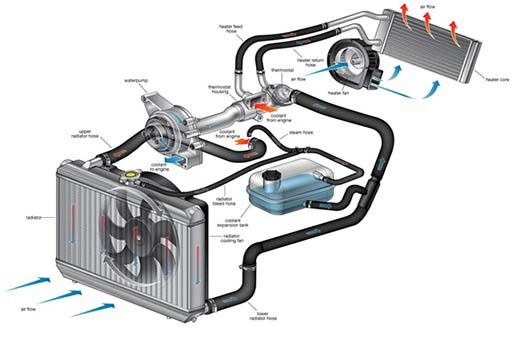Using the Correct Coolant
What’s cool about the correct coolant?
Coolant (or antifreeze) ensures your car’s engine runs at maximum efficiency by keeping it at just the right temperature. Conventional coolants are a mixture of anticorrosive additives, ethylene glycol, and water. Your car’s engine performs best at high temperatures but not so high as to cause damage to its components.
This is accomplished by cold coolant being forced through the radiator by the water pump and into the engine. Hot coolant coming out of the engine is forced back to the radiator to cool off before the cycle repeats.
When good coolant goes bad
Most coolants degrade over time as the ethylene glycol breaks down into primarily glycolic and formic acids. As corrosion-inhibiting chemicals are used up, electrolytic corrosion starts to eat away at the metal inside the engine and radiator. Once a coolant has degraded, and the pH drops, engine metals are at risk for corrosion.
As many of you know, Motor Werke is all about preventative maintenance. Most manufacturers recommend coolant replacement between 3-4 year intervals; some manufacturers call their coolant “lifetime” but this can be quite misleading. Although “lifetime” coolant can last to perform the task of lubrication, the anticorrosive additives will deteriorate at the same rate as non-lifetime coolant and your vehicle’s coolant, without those anticorrosive additives, will begin to eat away at components exposed to the coolant such as the water pump seals and water pump bearings.
Coolant should be tested regularly to ensure a perfectly neutral pH of 7.5. In most cars, when we test pH levels anything below a pH of 6.5 or higher than 9 is considered a failure and requires a cooling system flush. The protection level of brand-new coolant is -45 to -50 degrees Celsius; when the protection level is tested we typically don’t want to see anything warmer than -30 degrees Celsius. The less ability the anti-freeze has against freezing is again, considered a failure, and a cooling system flush should be performed.
It’s important to remember that it’s not always about whether the liquid can stand up over time but more so how the chemical breakdown of the fluid impacts the components that it comes into contact with.
Components that are already weakened by old acidic coolant will fail in the colder weather; any time there is extreme fluctuations in temperature from hot (operating temperature of your engine) to cold (ambient temperature outside), weak components rear their ugly head and fail.
Choosing the correct coolant for your car
Many of our clients think that all coolants are created equal regardless of brand or colour and for this reason, we perform a lot of coolant flushes! It is important to note that you should NEVER mix coolant types. Not all coolants contain glycol and mixing can turn your antifreeze into a gel!
A while back, one of our technicians had to replace a heater core on a MINI due to mixed coolant; the client had put regular Prestone coolant into his vehicle and about 1 year later his heater core was completely blocked, one side of the heater core was dangerously hot and the other side could be held with a bare hand.
Automobile manufacturers have very specific coolants for use in their vehicles. For example, the newer Volkswagen coolant is reddish-pink or purple in colour and is phosphate and silicate free. When supplied by Volkswagen, it is called G12 and is a permanent coolant. When the G12 is mixed with any other coolant, permanent damage can result.
At Motor Werke, we use ONLY factory coolant for all vehicles that we work on.
Figuring out what colour of antifreeze you should use isn’t as simple as matching colour to brand.
If your vehicle currently has, say, blue antifreeze and you think it will be simple to top up with more blue you may want to do some homework first. If that blue antifreeze is one of the newer blends, it can only be used if your cooling system has an aluminum radiator; green is the most common colour of coolant used in Japanese cars and they contain no silicates, but this is not the same as the green antifreeze you can get at your local parts store; the yellow coolant in some European cars contains silicates but it’s very different from the yellow Prestone brand; the red antifreeze is used by Toyota and blue antifreeze is used on some European cars like BMW; if your vehicle has a copper-and-brass radiator, orange (organic acid) antifreeze may not provide adequate protection for the lead solder in that radiator.
Remember, just because some coolants are the same colour, it doesn’t mean they have the same composition. Also, the colour of coolant in your expansion tank will change with wear and time, making it impossible to tell what colour is currently in your vehicle.
As you can see, the selection process isn’t as simple as it may seem. Even the simple task of topping up needs to be done with the correct coolant brand and type: some European and Korean formulas have silicates in them so using a generic brand will compromises the extended life formula that may already be in your vehicle.
When in doubt, consult your owner’s manual and bring your car into Motor Werke where we’ll know which colour and type of coolant is right for your vehicle.
Book your appointment today!





